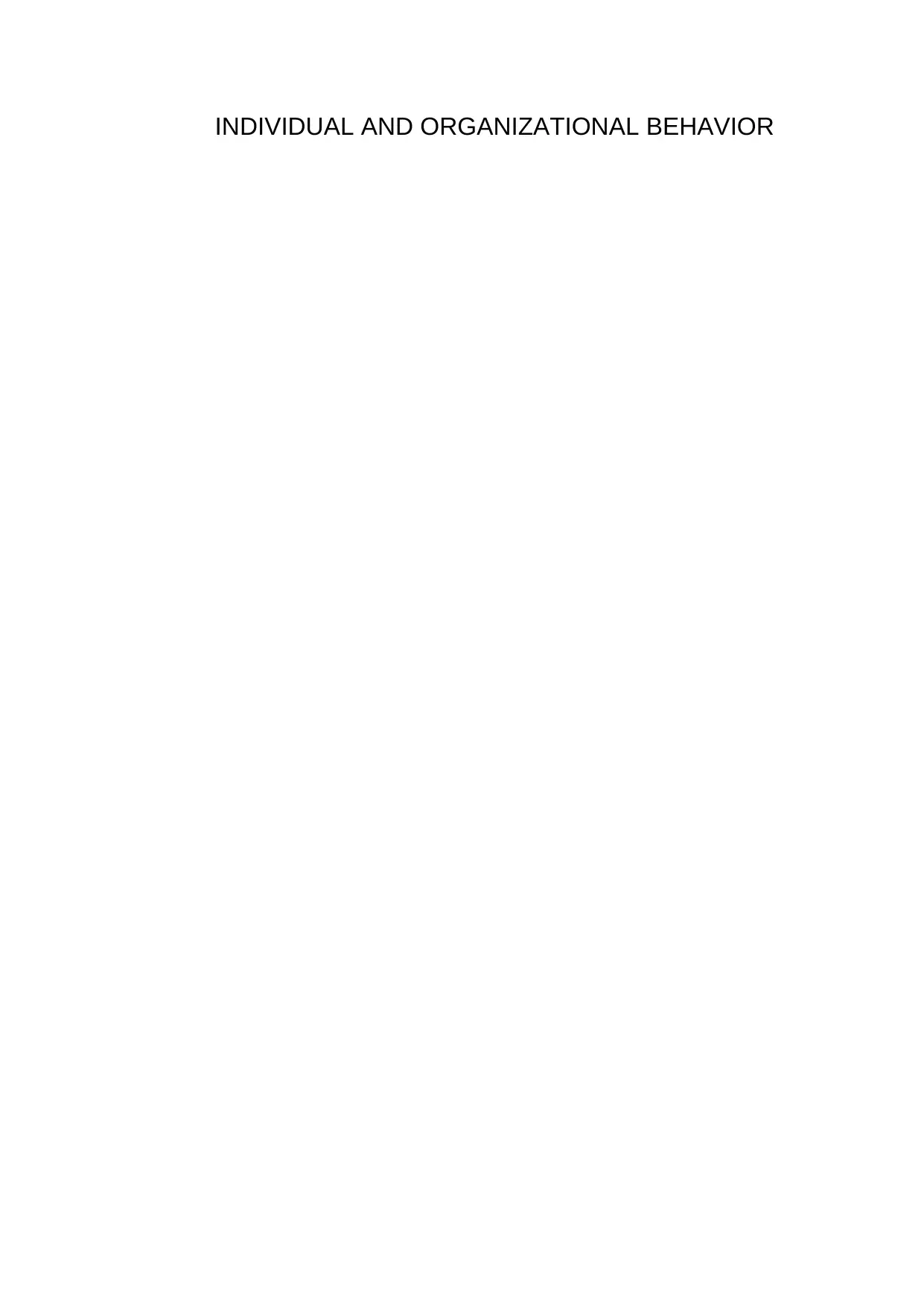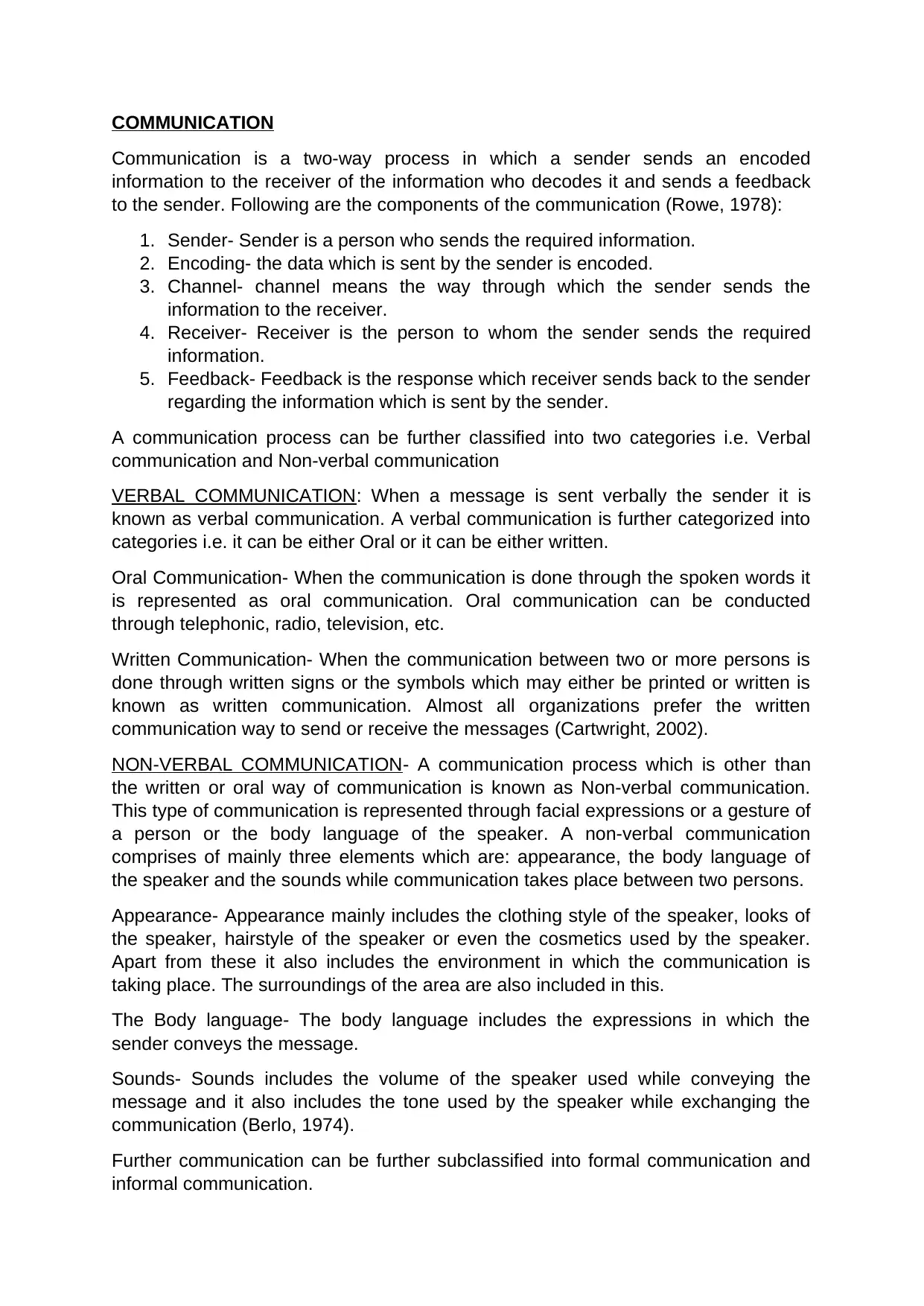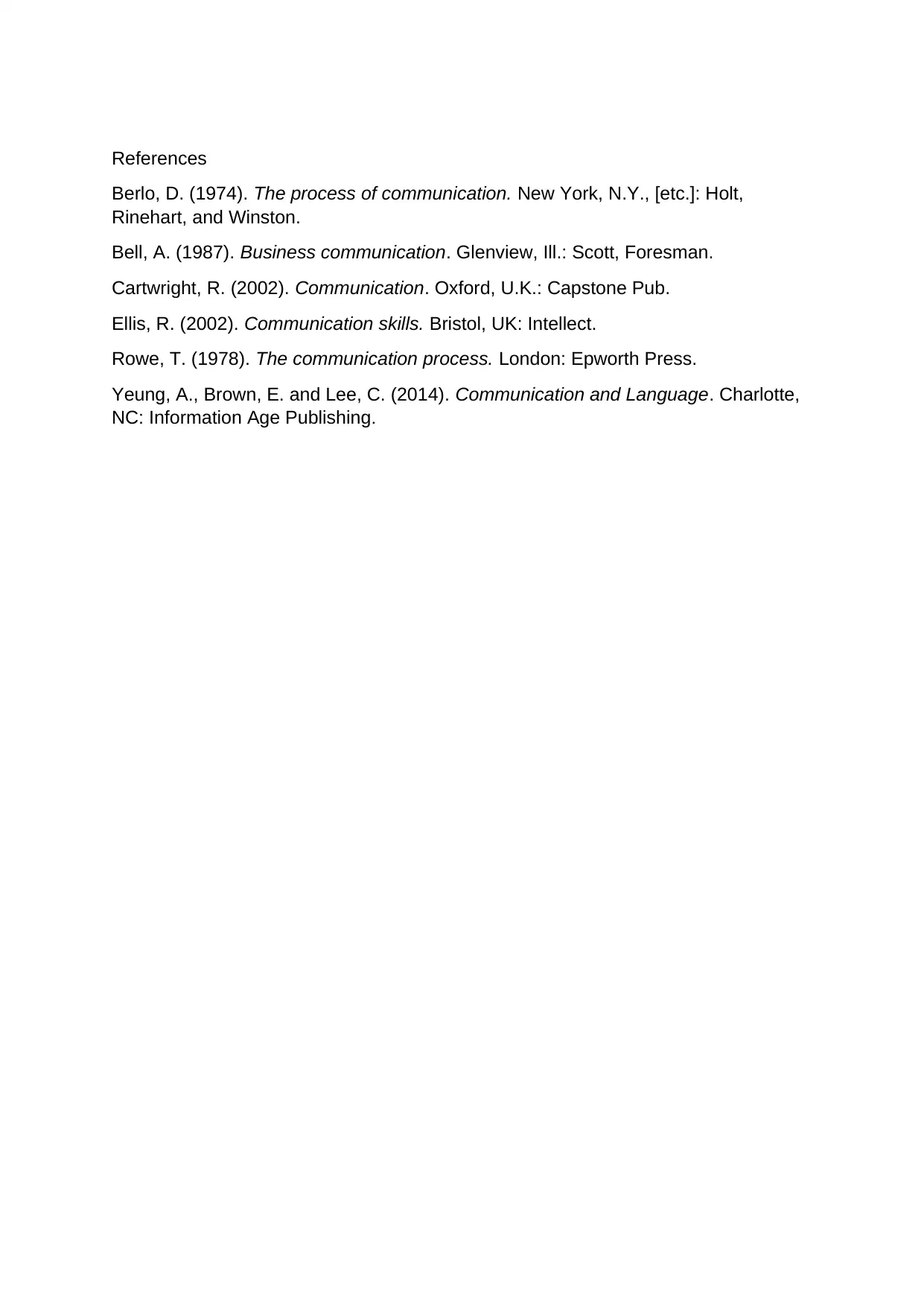Communication: Verbal and Non-Verbal, Formal and Informal, Barriers to Communication
VerifiedAdded on 2023/05/28
|4
|1006
|296
AI Summary
This article discusses the components of communication, including sender, encoding, channel, receiver, and feedback. It also covers verbal and non-verbal communication, formal and informal communication, and barriers to communication such as physical, language, gender, cultural, and emotional barriers.
Contribute Materials
Your contribution can guide someone’s learning journey. Share your
documents today.

INDIVIDUAL AND ORGANIZATIONAL BEHAVIOR
Secure Best Marks with AI Grader
Need help grading? Try our AI Grader for instant feedback on your assignments.

COMMUNICATION
Communication is a two-way process in which a sender sends an encoded
information to the receiver of the information who decodes it and sends a feedback
to the sender. Following are the components of the communication (Rowe, 1978):
1. Sender- Sender is a person who sends the required information.
2. Encoding- the data which is sent by the sender is encoded.
3. Channel- channel means the way through which the sender sends the
information to the receiver.
4. Receiver- Receiver is the person to whom the sender sends the required
information.
5. Feedback- Feedback is the response which receiver sends back to the sender
regarding the information which is sent by the sender.
A communication process can be further classified into two categories i.e. Verbal
communication and Non-verbal communication
VERBAL COMMUNICATION: When a message is sent verbally the sender it is
known as verbal communication. A verbal communication is further categorized into
categories i.e. it can be either Oral or it can be either written.
Oral Communication- When the communication is done through the spoken words it
is represented as oral communication. Oral communication can be conducted
through telephonic, radio, television, etc.
Written Communication- When the communication between two or more persons is
done through written signs or the symbols which may either be printed or written is
known as written communication. Almost all organizations prefer the written
communication way to send or receive the messages (Cartwright, 2002).
NON-VERBAL COMMUNICATION- A communication process which is other than
the written or oral way of communication is known as Non-verbal communication.
This type of communication is represented through facial expressions or a gesture of
a person or the body language of the speaker. A non-verbal communication
comprises of mainly three elements which are: appearance, the body language of
the speaker and the sounds while communication takes place between two persons.
Appearance- Appearance mainly includes the clothing style of the speaker, looks of
the speaker, hairstyle of the speaker or even the cosmetics used by the speaker.
Apart from these it also includes the environment in which the communication is
taking place. The surroundings of the area are also included in this.
The Body language- The body language includes the expressions in which the
sender conveys the message.
Sounds- Sounds includes the volume of the speaker used while conveying the
message and it also includes the tone used by the speaker while exchanging the
communication (Berlo, 1974).
Further communication can be further subclassified into formal communication and
informal communication.
Communication is a two-way process in which a sender sends an encoded
information to the receiver of the information who decodes it and sends a feedback
to the sender. Following are the components of the communication (Rowe, 1978):
1. Sender- Sender is a person who sends the required information.
2. Encoding- the data which is sent by the sender is encoded.
3. Channel- channel means the way through which the sender sends the
information to the receiver.
4. Receiver- Receiver is the person to whom the sender sends the required
information.
5. Feedback- Feedback is the response which receiver sends back to the sender
regarding the information which is sent by the sender.
A communication process can be further classified into two categories i.e. Verbal
communication and Non-verbal communication
VERBAL COMMUNICATION: When a message is sent verbally the sender it is
known as verbal communication. A verbal communication is further categorized into
categories i.e. it can be either Oral or it can be either written.
Oral Communication- When the communication is done through the spoken words it
is represented as oral communication. Oral communication can be conducted
through telephonic, radio, television, etc.
Written Communication- When the communication between two or more persons is
done through written signs or the symbols which may either be printed or written is
known as written communication. Almost all organizations prefer the written
communication way to send or receive the messages (Cartwright, 2002).
NON-VERBAL COMMUNICATION- A communication process which is other than
the written or oral way of communication is known as Non-verbal communication.
This type of communication is represented through facial expressions or a gesture of
a person or the body language of the speaker. A non-verbal communication
comprises of mainly three elements which are: appearance, the body language of
the speaker and the sounds while communication takes place between two persons.
Appearance- Appearance mainly includes the clothing style of the speaker, looks of
the speaker, hairstyle of the speaker or even the cosmetics used by the speaker.
Apart from these it also includes the environment in which the communication is
taking place. The surroundings of the area are also included in this.
The Body language- The body language includes the expressions in which the
sender conveys the message.
Sounds- Sounds includes the volume of the speaker used while conveying the
message and it also includes the tone used by the speaker while exchanging the
communication (Berlo, 1974).
Further communication can be further subclassified into formal communication and
informal communication.

Formal communication- A formal communication is one which follows the chain of
authority. No personal messages are sent through this type. Messages can be sent
either in the upward direction or it can be sent either in the downward direction. It
may take place through emails, meetings, memos, etc.
Informal communication- There is a spontaneous channel in the informal type of
communication. Personal messages or social messages can be exchanged under
this type. It may take in the form of gossip or either through rumor too.
BARRIERS TO COMMUNICATION
A Communication process must be evaluated to know whether the process is taking
place efficiently and effectively. A clear idea must be formed before communicating
and it must fulfill the needs of the receiver i.e. it should be according to the speaker.
There are always some barriers which are faced while the communication process
takes place (Ellis, 2002). List of some barriers which should be known while
communication process takes place is as follows:
1. Physical Barriers- the barriers which are faced by the people due to living in
different territories. A physical barrier is faced between the sender and the
receiver if they live in the different areas.
2. Language Barriers- Every country has its own language. So, while
communicating between two persons they must know each other’s language
in order to communicate effectively. Language does not include only the
actual language, but it also includes the facial expressions, buzzwords used
etc. If any of them is not aware of the language being used it may lead to
misinterpretations (Yeung, Brown and Lee, 2014).
3. Gender Barriers- The communication between the masculine and feminine
style vary. Mostly women emphasize the politeness and whereas male more
emphasize on saying things directly.
4. Cultural Barriers- People in a particular area follow different culture with
different religions and their different ethical values. Religious understandings
and the social understandings may differ which may lead to
misunderstandings between the sender of the message and the receiver of
the message.
5. Emotional Barriers- Anger, emotions of a person and fear are included in this
type of communication barrier. If one is consumed with emotions it may lead
to trouble in listening (Bell, 1987).
authority. No personal messages are sent through this type. Messages can be sent
either in the upward direction or it can be sent either in the downward direction. It
may take place through emails, meetings, memos, etc.
Informal communication- There is a spontaneous channel in the informal type of
communication. Personal messages or social messages can be exchanged under
this type. It may take in the form of gossip or either through rumor too.
BARRIERS TO COMMUNICATION
A Communication process must be evaluated to know whether the process is taking
place efficiently and effectively. A clear idea must be formed before communicating
and it must fulfill the needs of the receiver i.e. it should be according to the speaker.
There are always some barriers which are faced while the communication process
takes place (Ellis, 2002). List of some barriers which should be known while
communication process takes place is as follows:
1. Physical Barriers- the barriers which are faced by the people due to living in
different territories. A physical barrier is faced between the sender and the
receiver if they live in the different areas.
2. Language Barriers- Every country has its own language. So, while
communicating between two persons they must know each other’s language
in order to communicate effectively. Language does not include only the
actual language, but it also includes the facial expressions, buzzwords used
etc. If any of them is not aware of the language being used it may lead to
misinterpretations (Yeung, Brown and Lee, 2014).
3. Gender Barriers- The communication between the masculine and feminine
style vary. Mostly women emphasize the politeness and whereas male more
emphasize on saying things directly.
4. Cultural Barriers- People in a particular area follow different culture with
different religions and their different ethical values. Religious understandings
and the social understandings may differ which may lead to
misunderstandings between the sender of the message and the receiver of
the message.
5. Emotional Barriers- Anger, emotions of a person and fear are included in this
type of communication barrier. If one is consumed with emotions it may lead
to trouble in listening (Bell, 1987).

References
Berlo, D. (1974). The process of communication. New York, N.Y., [etc.]: Holt,
Rinehart, and Winston.
Bell, A. (1987). Business communication. Glenview, Ill.: Scott, Foresman.
Cartwright, R. (2002). Communication. Oxford, U.K.: Capstone Pub.
Ellis, R. (2002). Communication skills. Bristol, UK: Intellect.
Rowe, T. (1978). The communication process. London: Epworth Press.
Yeung, A., Brown, E. and Lee, C. (2014). Communication and Language. Charlotte,
NC: Information Age Publishing.
Berlo, D. (1974). The process of communication. New York, N.Y., [etc.]: Holt,
Rinehart, and Winston.
Bell, A. (1987). Business communication. Glenview, Ill.: Scott, Foresman.
Cartwright, R. (2002). Communication. Oxford, U.K.: Capstone Pub.
Ellis, R. (2002). Communication skills. Bristol, UK: Intellect.
Rowe, T. (1978). The communication process. London: Epworth Press.
Yeung, A., Brown, E. and Lee, C. (2014). Communication and Language. Charlotte,
NC: Information Age Publishing.
1 out of 4
Related Documents
Your All-in-One AI-Powered Toolkit for Academic Success.
+13062052269
info@desklib.com
Available 24*7 on WhatsApp / Email
![[object Object]](/_next/static/media/star-bottom.7253800d.svg)
Unlock your academic potential
© 2024 | Zucol Services PVT LTD | All rights reserved.





